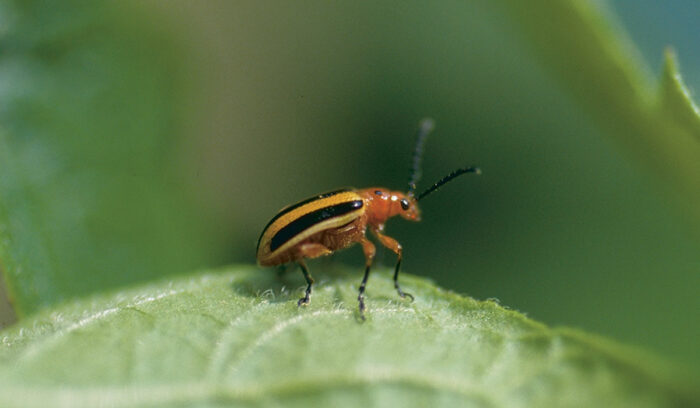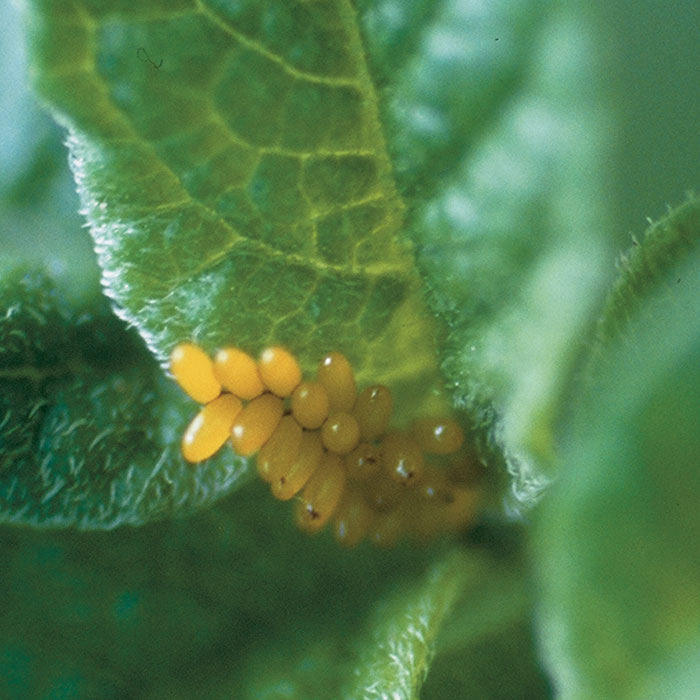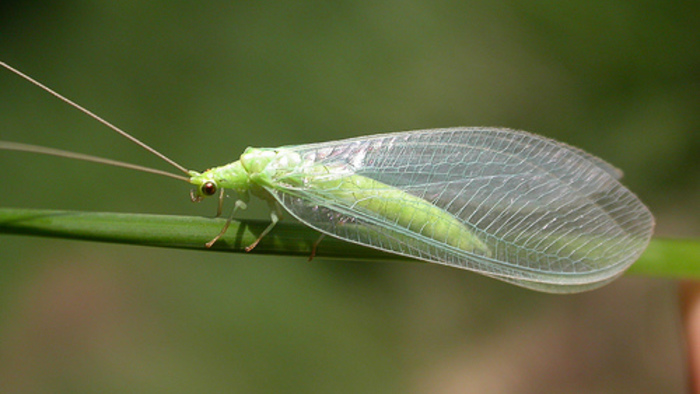
The pretty yellow-and-black-striped Colorado potato beetle is native to wild Solanaceous plants of the semi-arid western United States. Our problem with it began when the beetle broadened its gustatory interests to include cultivated plants in the same family, such as potato, eggplant, and tomato. It has since expanded its range to include most of North America and Europe.
Because the Colorado potato beetle has become resistant to a large number of conventional pesticides, researchers have pursued alternative methods of control. As a kitchen gardener, you can choose from physical, horticultural, or biological controls. Most likely, a mix of strategies will be your best policy.
Rotation—the old standby
In spring, adult Colorado potato beetles emerge from hibernation in the soil and search out food plants for feeding and egg-laying. The feeding beetles lay yellow-orange eggs clustered in groups, usually on the undersides of leaves. The larvae, which look like fat, globular, slow-moving caterpillars, change from brown to pink as they grow, developing two rows of black spots along each side of their abdomen (top right photo, below). When fully grown, in 20 to 24 days, the larvae burrow into the soil to pupate near the plants on which they were feeding. Emerging as adults, a week to two weeks later (depending on the temperature), they start the process again. The second generation of adults remains in the soil until the next spring.
The adult beetles are poor flyers and cannot easily travel far. For this reason, the rotation of crops away from where Solanaceous plants have been planted before is a traditional means of controlling Colorado potato beetle. Unfortunately for the kitchen gardener, the new plantings ideally should be at least 200 feet away from the old site. Even in small gardens, however, it’s still a good idea to rotate each piece of ground to a different plant family, because other pests, including soil-borne pathogens, remain behind from each year’s plantings.

Handpick, vacuum, or trap
Physical controls satisfy the urge for immediate revenge on a pest for the damage it causes, and against the Colorado potato beetle, you have several choices. Handpicking may be all you need to protect a small plot of potatoes. Picking is easiest early in the day when the beetles are cold and slow to move. Collect the beetles in a wide-mouth jar, coffee can, or deep baking pan, half full of soapy water. Place the container below leaves with beetles or larvae and shake the plant. The insects will fall into the container and drown. Larvae and egg masses also can be squished on the leaves. Gloves make the job easier.
Another physical control option is to vacuum up the beetles. Small, rechargeable hand-held vacuums can be quite
effective with Colorado potato beetles and other large insect pests. We have also used a water vacuum, which sucks the beetles into a cylinder of soapy water, although its long power cord carries the danger of tripping us or decapitating a plant or two.
To prevent the beetles from reaching early-sprouting tubers, especially in large plantings, you might want to dig a barrier ditch around your potato bed. The early colonizers walk to their first food sources. A near-vertical-sided, plastic-lined, dry ditch 4 to 6 inches deep and 4 inches wide cutting across their line of movement can trap these migrants and prevent early colonization.
Timing and trap crops
Planting dates turn out to be important for the control of Colorado potato beetle. A standard recommendation is to plant potatoes very early (early April in Ohio, for instance), so that the plants bloom before June, and the beetle damage occurs too late to affect yield. To advance the season, place plastic sheets on the soil to warm it up.
Shifting planting dates at the other end is also a possibility. If your season length permits it, delay planting altogether until a month or more past May.
Another option is to plant an early potato crop as a trap crop. When the early crop is attacked, you can kill the beetles with a flamer. For a small garden, an ordinary hand-held propane torch will work as well as a long-handled weed flamer. Potato sprouts are fairly resistant to heat damage, and early sprouts attacked by the beetles will re-grow even if they’ve been damaged by fire. Or you can plant a main crop directly after flaming. Keep in mind that flaming cannot be used with a straw mulch or other inflammable mulch materials.

Mulches and row covers
Planting potatoes in, or just beneath, a thick straw mulch has been shown to reduce damage from a number of potato pests, including aphids and flea beetles, as well as Colorado potato beetles. Mulches attract predators, such as carabid ground beetles and hunting spiders, which feed at night. But mulches may not be successful in damp cold areas where slugs are a problem.
As is the case with so many pest problems in small vegetable gardens, preventing migrating insects from reaching the plants by using row covers is a useful tactic. Anchor the covers securely into the soil because Colorado potato beetles are strong walkers and could move in under unburied row cover edges.
Nematodes and parasites
The deliberate introduction of biological controls can be effective against the Colorado potato beetle. The cost of these predators and parasites may make it desirable for you to split the purchase with friends and neighbors. But releasing just one batch can help restore natural enemies of the beetles to areas depleted by years of spraying or habitat destruction.
Before planting, you can introduce purchased beneficial nematodes into the beds. Be sure the soil is moist, and carefully follow the package instructions. We water in nematodes late in the day to prevent them from drying out before moving into the soil. The nematodes are most effective in light, well-drained soils, since they move within the soil and water solution. Heavy clay soils discourage their distribution below ground. Beneficial nematodes attack the overwintering beetles as they lie buried in the soil. They will help reduce flea beetle and click beetle larvae as well.
The tiny parasitic mini-wasp Edovum puttleri is also commercially available. Research has shown that it may parasitize up to 50 percent of the Colorado potato beetle egg masses on potatoes and an even higher percentage on eggplant (up to 91 percent). If you grow both potatoes and eggplant where Colorado potato beetle is a problem, you may find it worthwhile to release Edovum puttleri. Many garden catalogs include this species. Release the wasps when you see the first yellow egg masses. Release them again on the second batch of eggs in early summer. In many areas this second batch of eggs is the start of the heavy damage period.
There are also a number of predatory insects that feed heavily on Colorado potato beetles. Soldier bugs are one such predator, and there is now a commercially available attractant to increase their numbers in the garden. At first glance, soldier bugs look like stink bugs, but by watching you may see them attack other insects. Among your vegetables, include plantings that bring in the natural predators and parasites of a wide variety of pests. Coriander, dill, fennel, and sweet alyssum will sustain many beneficial insects, including some that prey on Colorado potato beetles.
Need image for this caption (original TIFF image in archive too small): The yellow and black striped Colorado potato beetle overwinters near plantings it infested the previous year, so rotating crops may provide some protection against it.
Insect diseases
In general, a good way to reduce insect pest numbers is with a pathogen that causes disease in the insect, is specific to it, but does not kill its natural enemies. A number of new Btt (Bacillus thuringiensis tenebrionis) products have high selectivity for Colorado potato beetles and virtually no mammalian toxicity. Btt works best against the early larval stages, so must be timed properly. Wait until all the egg masses have hatched. You can tell because only the shells will be left, and little larvae will be crawling nearby. The larvae have to eat the Btt from the leaf, so coat the leaves thoroughly, especially the undersides.
This Btt is different from the better-known Bt pathogen used to control caterpillars. Be careful to get the right product. Like all live biological products, Btt can be damaged by long storage and high heat, so purchase it from a reliable source. Follow the directions carefully, since mixing with soft water (low pH) is essential. The directions will tell you how to do this and what remedy to follow if your water is hard (i.e., it contains calcium and other minerals).
Beauveria bassiana is a commercially available fungal pathogen that is effective against Colorado potato beetles. Beauveria bassiana has a wider host range than Btt and works best under moist conditions. As with the Btt, it is most effective against the young larvae. However, it can also be sprayed directly on the beetles.
With so many methods available for preventing intolerable damage, you can keep a few Colorado potato beetles in the garden as appreciated wildlife rather than as overwhelming pests.
—Helga Olkowski and co-authors William Olkowski and Sheila Daar are authors of Common Sense Pest Control (Taunton Press).
April 2000
From Kitchen Gardening #26

















Comments
Log in or create an account to post a comment.
Sign up Log in